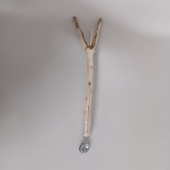Paul Eusey wrote:
Tinamarie Maison wrote:I’m really not sure how to make the acre marshland into a harmonious feature!
Lots of good advice thus far and I figured I would give you some thoughts on yer marsh quandary. I haven't seen your particular marsh, but marshes that I have seen have basically been water stuck in place or places where water collects enough to be a marsh, but not enough to be a pond. They don't always have to stay in place and some can be altered and transformed.
This is one of those things that falls into a bit of a grey area for some people. Not for me. Converting a marshy wetland into a pond is admirable and desireable.
At one time, the entire North American continent was inhabited by beavers. Some estimate that there were upwards of 200 million beavers or more. They lived by damming streams and creating wetlands. As a keystone species, beavers are engineers that fundamentally altered the landscape for their purposes. Your marshland is most likely a former beaver pond. Century after century, beavers would create these wetlands, and then would abandon them when they'd exhausted the forest that they depended upon for food and shelter. 10 or 20 years later, they'd return to find a re-sprouted forest. That cycle repeated itself for a millenia or longer.
So today, when some county water conservation person comes along and says, "You can't touch that wetland! It's protected.", there is an assumption that it has always been that way and it always will remain that way. That's naive and incorrect. Beavers have been excavating that wet spot forever.
Some September or October after you've a had a long dry summer, get in there with an excavator and dig yourself a nice pond. I wouldn't go advertising this to anyone—that's only asking for additional scrutiny. The soil you dig out will be black and fertile—perfect for raised beds or a garden space If there is a clear direction that the water flows across the area, leave some of the wetland above and below your pond to serve as a filter as well as keeping the wetlands nazis off your back. It doesn't have to be that deep -- perhaps 10 or 15 feet at the most -- but it will create a habitat for fish, ducks, and other aquadic life that do not currently use the marsh. A piece of heavy equipment like that can be rented for about $1000 to $2000 a day. You may also need a truck to haul away the soil. But it's worth the investment.
Then stock the pond with fish that thrive in your area. Mmmm . . . fresh fish.







